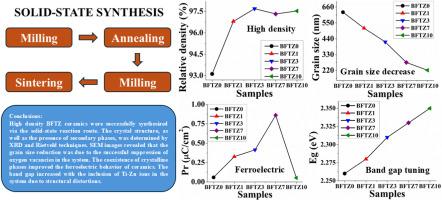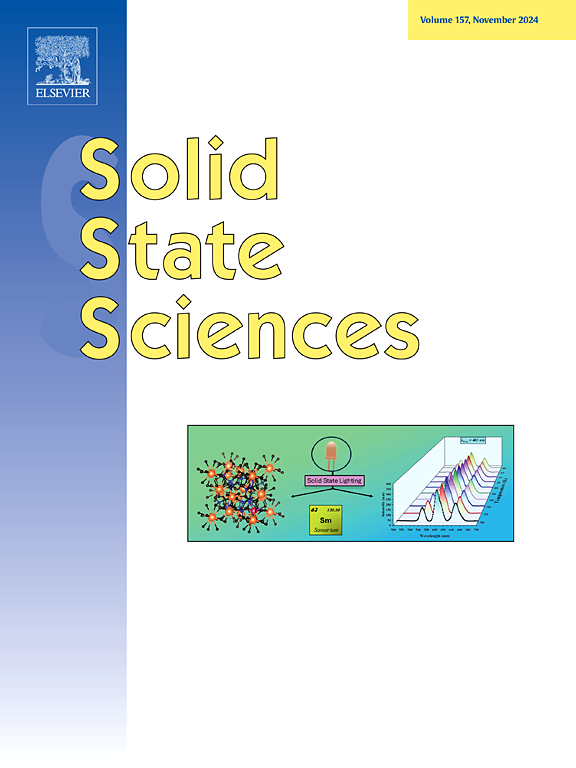Influence of Ti-Zn doping on the structural, ferroelectric and optical properties of BiFeO3 ceramics synthesized via the solid-state reaction
IF 3.3
3区 化学
Q2 CHEMISTRY, INORGANIC & NUCLEAR
引用次数: 0
Abstract
BiFeO3 is a perovskite-type structure material with diverse applications in modern devices. In this study, powders and bulk ceramics of the solid solution BiFe1-2xTixZnxO3, also known as BFTZ, were synthesized via a solid-state reaction, and their physical properties were analyzed. Structural properties obtained by X-ray diffraction and Rietveld refinements revealed that the incorporation of Ti and Zn ions in the solid solution increased the lattice parameter “a” (from 5.5825 Å to 5.6039 Å) and decreased the “c” parameter (from 13.8720 Å to 13.7713 Å). The coexistence of the R3c and P4mm crystalline phases was determined, specifically the phase transition from R3c to P4mm with the addition of 10 % Ti–Zn in the solid solution. Scanning electron micrographs revealed a decrease in the average grain size from 624 nm to 221 nm. Ferroelectric measurements revealed an increase in the remnant polarization from 0.058 μC/cm2 to 0.863 μC/cm2. Finally, the material's band gap remained within the visible light range in all samples, increasing from 2.26 eV to 2.35 eV. This demonstrates that the obtained material is a candidate for use in optoelectronic devices with ferroelectric properties.

Ti-Zn掺杂对固相反应合成的BiFeO3陶瓷结构、铁电性能和光学性能的影响
BiFeO3是一种钙钛矿型结构材料,在现代设备中具有多种应用。本研究通过固相反应合成了固溶体BiFe1-2xTixZnxO3(也称为BFTZ)的粉末和块状陶瓷,并对其物理性能进行了分析。通过x射线衍射和Rietveld细化得到的结构性质表明,Ti和Zn离子在固溶体中的掺入增加了晶格参数“a”(从5.5825 Å到5.6039 Å),降低了“c”参数(从13.8720 Å到13.7713 Å)。确定了R3c和P4mm晶相的共存,特别是在固溶体中添加10% Ti-Zn时,从R3c到P4mm的相变。扫描电镜显示,平均晶粒尺寸从624 nm减小到221 nm。铁电测量表明,残余极化从0.058 μC/cm2增加到0.863 μC/cm2。最后,材料的带隙在所有样品中都保持在可见光范围内,从2.26 eV增加到2.35 eV。这表明所获得的材料是用于具有铁电性质的光电器件的候选材料。
本文章由计算机程序翻译,如有差异,请以英文原文为准。
求助全文
约1分钟内获得全文
求助全文
来源期刊

Solid State Sciences
化学-无机化学与核化学
CiteScore
6.60
自引率
2.90%
发文量
214
审稿时长
27 days
期刊介绍:
Solid State Sciences is the journal for researchers from the broad solid state chemistry and physics community. It publishes key articles on all aspects of solid state synthesis, structure-property relationships, theory and functionalities, in relation with experiments.
Key topics for stand-alone papers and special issues:
-Novel ways of synthesis, inorganic functional materials, including porous and glassy materials, hybrid organic-inorganic compounds and nanomaterials
-Physical properties, emphasizing but not limited to the electrical, magnetical and optical features
-Materials related to information technology and energy and environmental sciences.
The journal publishes feature articles from experts in the field upon invitation.
Solid State Sciences - your gateway to energy-related materials.
 求助内容:
求助内容: 应助结果提醒方式:
应助结果提醒方式:


